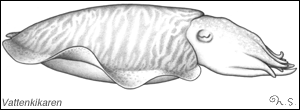|

|
|
Regulates bouyancy
A cuttlefish wants to achieve the same
density as the surrounding water. If it has a higher density, it will
sink, while a lower will cause it to float. Except for the cuttlebone
the body of the cuttlefish is somewhat denser than sea water. By regulating
the gas and liquid content of the cuttlebone, the cuttlefish is able adjust
its bouyancy and remain neutral.
Because the thin plates that contain the cavities are rigid,
volume changes do not occur with variations in pressure when the cuttlefish
changes its depth. Compared to fish that have a swim bladder, the cuttlefish
can move around in the water without having to change its bouyancy. Besides
controlling bouyancy, the cuttlebone gives something for the muscles to
work against.

Ten arms
The body of the cuttlefish can be divided
into three parts: the hind with the skeleton and the intestines, the middle
with the head, and the frontal with the arms. The hind of the cuttlefish
is long, slim, slightly flat with a thin peripheral fin. This part can
be up to 40 cm, which would represent a total length of about 60 cm and
about 5 kg in weight. .
Of the 10 arms, 2 are longer. The longer arms
are known as tentacles and are retractable. The arms have 4
rows of suckers, but the tentacles only have suckers on the
spoon shaped ends.
|

|
Page
2 of 4
|

|
|